August Wilson’s The Piano Lesson is a luminous drama set in 1930s Pittsburgh, exploring family legacy, racial identity, and financial struggles through the symbolic piano’s haunting presence․
Overview of the Play
The Piano Lesson is a powerful drama by August Wilson, set in 1930s Pittsburgh․ The story centers on the Charles family, particularly siblings Boy Willie and Berniece, who confront their troubled past․ The play explores themes of family legacy, racial identity, and financial struggles, with the piano serving as a central symbol of their heritage․ The piano, carved with ancestral images, represents the family’s history of slavery and resilience․ Boy Willie wants to sell it to buy land, while Berniece insists on preserving it․ Their conflict unfolds against the backdrop of their shared traumatic experiences and the broader context of African American life during the Great Migration․ The play is a poignant exploration of history, memory, and the weight of inheritance․
Historical Context: 1930s Pittsburgh
Set in 1930s Pittsburgh, The Piano Lesson reflects the city’s industrial boom and racial tensions․ Pittsburgh’s steel and coal industries attracted African Americans during the Great Migration, yet systemic racism persisted․ The Hill District, a vibrant Black community, faced poverty and segregation․ This backdrop influences the Charles family’s struggles with identity, economic hardship, and cultural preservation․ The play captures the era’s duality of opportunity and oppression, where African Americans sought better lives while confronting discrimination․ Wilson’s portrayal of Pittsburgh highlights the resilience of Black communities amidst adversity, tying the family’s history to the broader African American experience of the time․
Significance of the Piano as a Symbol
The piano in The Piano Lesson symbolizes the Charles family’s history and cultural identity․ Carved with ancestral figures, it represents their enslaved heritage and the memories of their ancestors․ The instrument embodies both beauty and pain, serving as a tangible connection to the family’s past․ Boy Willie views it as a means to achieve financial freedom, while Berniece sees it as a sacred heirloom․ This conflict over the piano’s purpose highlights the tension between preserving cultural legacy and seeking economic advancement․ The piano becomes a powerful metaphor for the African American experience, reflecting the struggle to honor history while pursuing a better future․
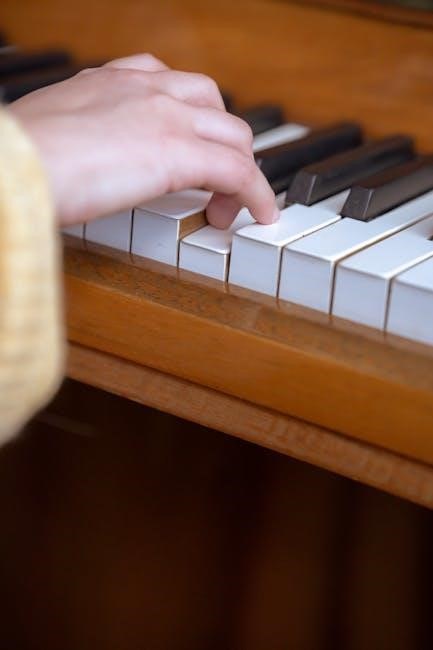
The Plot of “The Piano Lesson”
The Piano Lesson follows the conflict between Boy Willie and Berniece over their family’s heirloom piano in 1930s Pittsburgh, exploring their troubled past, cultural identity, and differing aspirations․
In The Piano Lesson, the characters are deeply intertwined with their family’s history and the symbolic piano․ Boy Willie, a determined and ambitious man, seeks to sell the piano to buy land, while his sister Berniece, guarded and emotionally scarred, insists on preserving it as a link to their ancestors․ Their uncle Doaker, a quiet observer, tries to mediate, and Maretha, Berniece’s daughter, represents the younger generation․ The characters’ interactions reveal their struggles with identity, legacy, and economic survival, set against the backdrop of 1930s Pittsburgh․ Their stories are rooted in the piano’s carved history, which holds the memories of their enslaved ancestors․
The Conflict Between Boy Willie and Berniece
The central conflict in The Piano Lesson arises between Boy Willie and Berniece over the family’s heirloom piano․ Boy Willie, driven by ambition and economic aspirations, wants to sell the piano to buy land, believing it will secure his future․ Berniece, however, sees the piano as a sacred connection to their enslaved ancestors and refuses to part with it․ Their clash is not just about the piano but about their conflicting values—Between economic progress and cultural preservation․ Tensions escalate as Boy Willie’s persistence challenges Berniece’s emotional attachment, revealing deeper wounds from their shared traumatic past․ Their struggle reflects the broader themes of identity, heritage, and survival․
The Role of the Piano in the Story
The piano in The Piano Lesson is a central symbol, representing the family’s history and cultural legacy․ Carved by their enslaved ancestor, it depicts scenes of their family’s traumatic past, including the violent separation of their ancestors․ The piano serves as a tangible connection to their heritage, embodying the pain, resilience, and memories of generations․ Its presence ignites a fierce debate between Boy Willie and Berniece, with Boy Willie viewing it as a means to economic freedom and Berniece seeing it as an irreplaceable piece of their identity․ The piano’s significance extends beyond its material value, becoming a catalyst for the characters’ confrontation with their past and their struggle to reconcile heritage with progress․

Themes in “The Piano Lesson”
August Wilson explores themes of family history, racial identity, and financial struggles, weaving them through the piano’s symbolic presence to reflect the characters’ emotional and cultural journey;
Family History and Legacy
In The Piano Lesson, August Wilson intricately explores the theme of family history and legacy through the symbolic piano, carved by the family’s enslaved ancestors․ The piano serves as a tangible connection to the Washington family’s past, with its carvings depicting their ancestral stories․ Berniece, the guardian of the piano, views it as a sacred heirloom, while Boy Willie sees it as a commodity to sell for land․ This conflict underscores the tension between preserving cultural heritage and pursuing economic advancement․ The piano becomes a symbol of identity, memory, and resilience, reflecting the broader African American experience of grappling with history and legacy in a changing world․
Race and Identity
In The Piano Lesson, August Wilson explores the profound impact of race and identity on the African American experience․ The play delves into the historical trauma of slavery and segregation, which shapes the characters’ lives․ The piano, carved by the family’s enslaved ancestors, symbolizes both the pain of oppression and the resilience of their cultural identity․ Through characters like Boy Willie and Berniece, Wilson examines the tension between embracing one’s heritage and striving for a better future․ The play highlights the struggle to reclaim and honor African American identity in a society dominated by racial inequality, offering a powerful commentary on the legacy of racism and the strength of cultural pride․
Financial Struggles and Aspirations
Financial struggles and aspirations are central to The Piano Lesson, reflecting the economic challenges faced by African Americans in the 1930s․ Boy Willie’s desire to sell the family piano to purchase land embodies his aspiration for financial stability and a better future․ The piano, a valuable asset, represents both a connection to the past and a potential pathway to economic freedom․ Berniece, however, prioritizes preserving their cultural heritage over immediate financial gain, highlighting the tension between economic aspirations and the importance of maintaining family legacy․ Through these characters, Wilson explores the complexities of financial decisions in the pursuit of a more secure and dignified life․
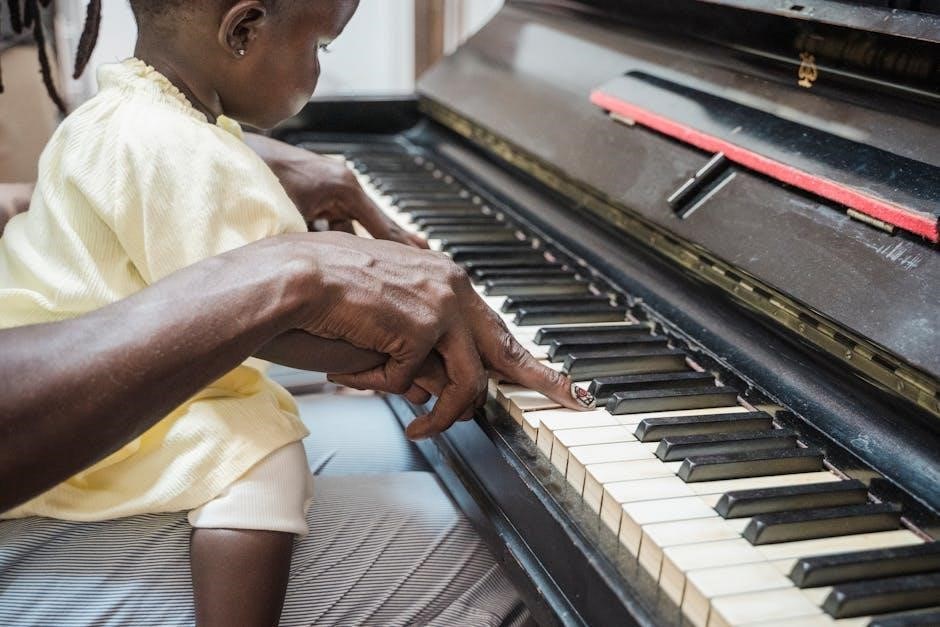
August Wilson’s Writing Style
Wilson masterfully blends dialogue, dialect, and music, creating a rich tapestry of African American life, exploring identity, history, and resilience through poetic, evocative storytelling․
Use of Dialogue and Dialect
August Wilson’s masterful use of dialogue and dialect in The Piano Lesson captures the rhythm and authenticity of African American speech, reflecting the cultural identity of his characters․ The rich, lyrical language rooted in the Black vernacular conveys deep emotional and historical contexts․ Through dialogue, Wilson explores themes of family, race, and resilience, creating vivid portrayals of characters like Boy Willie and Berniece․ The dialect preserves the heritage and struggles of the community, while also highlighting generational and ideological conflicts․ Wilson’s approach ensures that the voices of his characters resonate with both authenticity and poetic beauty, making the play a powerful exploration of African American life and legacy;
Blending Drama and Music
August Wilson seamlessly integrates drama and music in The Piano Lesson, creating a rich, auditory tapestry that enhances the emotional depth of the story․ The piano itself is a central character, its melodies and rhythms evoking memories of the family’s history and cultural heritage․ Music becomes a form of storytelling, bridging generations and connecting the past to the present․ Wilson’s use of song and musical dialogue adds layers of meaning, allowing characters to express emotions that words alone cannot convey․ This fusion of drama and music not only reflects the African American tradition of using song as a narrative tool but also heightens the play’s emotional resonance and universal appeal․
Wilson’s Exploration of the African American Experience
August Wilson’s The Piano Lesson is a profound exploration of the African American experience, delving into themes of identity, history, and resilience․ The play captures the complexities of racial oppression and the enduring strength of cultural heritage․ Through the Charles family’s story, Wilson examines the intergenerational impact of slavery and segregation, while celebrating the richness of African American traditions․ The piano, adorned with carvings of ancestors, serves as a testament to the family’s history and their connection to their roots․ Wilson’s work underscores the struggle to preserve cultural identity amidst systemic inequality, offering a powerful commentary on race and legacy in America․
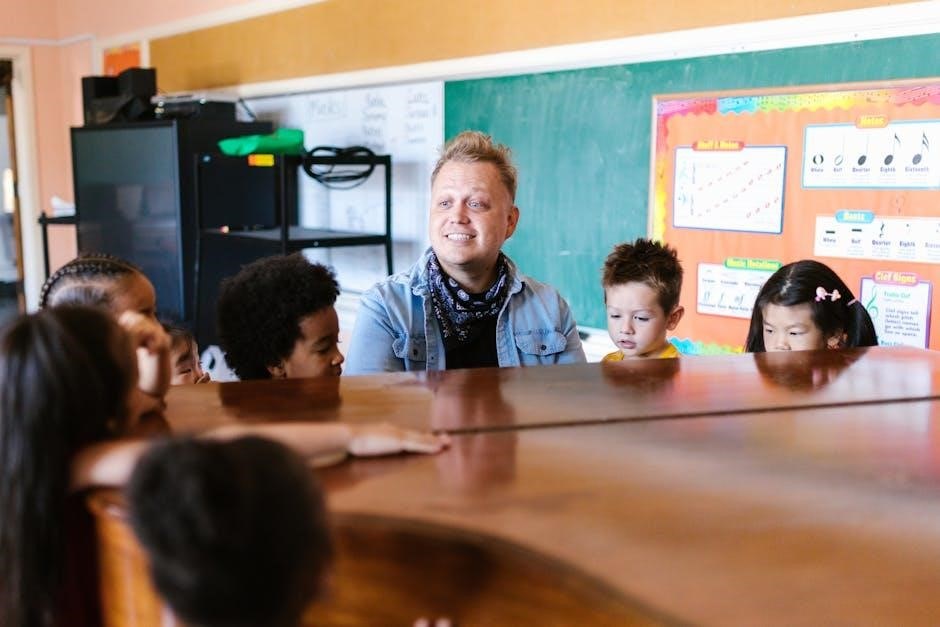
The Washington Family’s Involvement
The Washington family has significantly contributed to The Piano Lesson, with Denzel Washington producing and his son, Malcolm, making his directorial debut․ Their involvement highlights the play’s cultural importance and brings fresh perspectives to Wilson’s timeless story․
Malcolm Washington’s Directorial Debut
Malcolm Washington, son of Denzel Washington, made his directorial debut with The Piano Lesson, bringing a fresh perspective to August Wilson’s iconic play․ His involvement marks a significant milestone, blending respect for the original work with modern storytelling techniques․ Washington’s direction emphasizes the emotional depth of the characters and the cultural resonance of the piano, ensuring the story remains authentic while appealing to new audiences․ His debut highlights the importance of intergenerational storytelling and the enduring relevance of Wilson’s themes․ This adaptation not only honors the play’s legacy but also introduces it to a contemporary audience, ensuring its continued impact․ Malcolm’s direction is a testament to the play’s timeless appeal and his own emerging talent in storytelling․
John David Washington’s Role as Boy Willie
John David Washington brings a dynamic energy to his portrayal of Boy Willie in The Piano Lesson, capturing the character’s charisma and determination․ Known for his roles in Tenet and BlacKkKlansman, Washington infuses Boy Willie with a modern flair while staying true to August Wilson’s original vision․ His performance highlights the character’s relentless pursuit of a better life and his complex relationship with Berniece․ Washington’s interpretation balances Boy Willie’s stubbornness with his deep connection to family history, making him both formidable and relatable․ His portrayal bridges the gap between generations, offering a fresh perspective on Wilson’s timeless character․ This role underscores Washington’s versatility as an actor and his ability to embody the nuances of Boy Willie’s journey․
Danielle Deadwyler’s Portrayal of Berniece
Danielle Deadwyler delivers a powerful and nuanced performance as Berniece in The Piano Lesson, bringing depth and complexity to the character․ Known for her roles in Till and The Harder They Fall, Deadwyler captures Berniece’s resilience and emotional richness․ She masterfully conveys the character’s internal struggles, balancing strength with vulnerability․ Deadwyler’s portrayal highlights Berniece’s role as the emotional anchor of the family, emphasizing her connection to the piano and its historical significance․ Her performance resonates with audiences, offering a compelling exploration of identity, heritage, and the weight of family legacy․ Deadwyler’s interpretation of Berniece is both authentic and haunting, making her a standout in the adaptation of August Wilson’s timeless play․
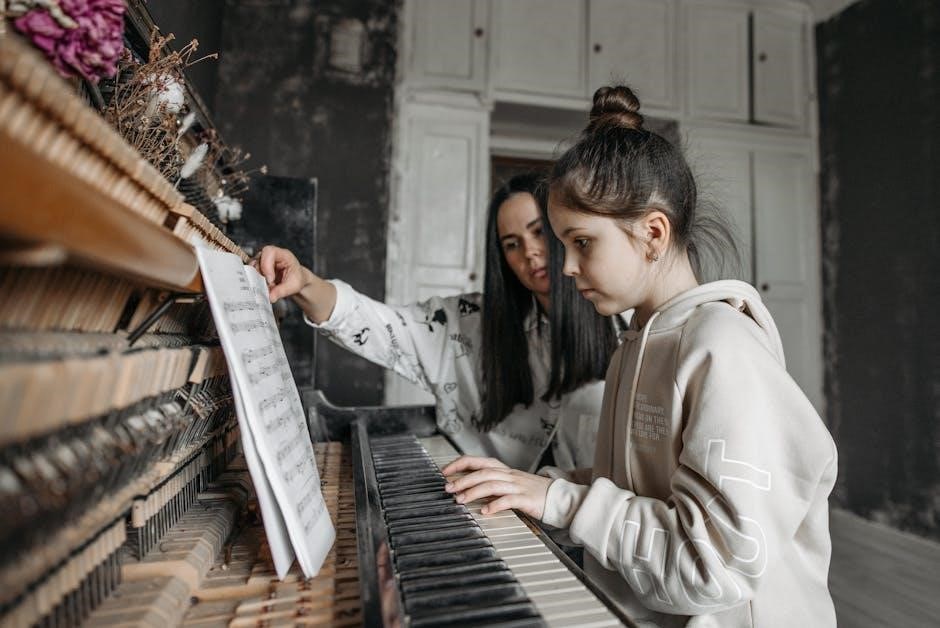
Adaptation into Film
The film adaptation of The Piano Lesson captures the emotional depth and cultural richness of August Wilson’s play, translating its powerful themes into a visual narrative․
Challenges of Translating the Play to Screen
Adapting August Wilson’s The Piano Lesson into a film presented significant challenges, particularly in preserving the play’s emotional intensity and cultural depth․ The stage play relies heavily on dialogue and a single setting, which must be expanded for the screen․ Translating the symbolic weight of the piano and the complex family dynamics required careful visual storytelling․ Additionally, maintaining the play’s pacing while adapting to the demands of cinematic narrative was crucial․ Filmmakers had to balance fidelity to the original work with the need to create a visually engaging experience․ These challenges highlight the delicate process of bringing Wilson’s powerful story to life in a new medium․
The Vision of the Filmmakers
The filmmakers behind the adaptation of The Piano Lesson aimed to honor August Wilson’s original vision while expanding its reach through cinema․ Their primary goal was to maintain the play’s emotional depth and cultural richness, ensuring the story resonated with both familiar and new audiences․ They focused on preserving the intricate dialogue and the symbolic significance of the piano, blending it with visual storytelling to enhance the narrative․ The filmmakers also emphasized the importance of casting actors who could authentically portray the complexities of the characters․ By balancing fidelity to the source material with creative freedom, they sought to create a film that would stand as a testament to Wilson’s legacy and the enduring power of the story․
Reception of the Film Adaptation
The film adaptation of The Piano Lesson received widespread critical acclaim for its faithful translation of August Wilson’s play to the screen․ Critics praised the cast’s powerful performances, particularly the portrayals of Boy Willie and Berniece, which captured the emotional depth of the characters․ Audiences resonated with the film’s exploration of family legacy and racial identity, finding it both haunting and deeply moving․ The adaptation was celebrated for its ability to preserve the play’s cultural significance while introducing the story to a new generation․ It also sparked important conversations about the importance of preserving African American history and artistic expression, further cementing its impact beyond the theatre․

Samuel L․ Jackson’s Connection to the Play
Samuel L․ Jackson played Boy Willie in an early production of The Piano Lesson, marking a pivotal role in his career․ His portrayal showcased his talent and helped popularize the play, bringing attention to August Wilson’s work․
His Early Role as Boy Willie
Samuel L․ Jackson’s portrayal of Boy Willie in The Piano Lesson marked a significant milestone in his career․ His dynamic performance captured the character’s determination and emotional depth, resonating deeply with audiences․ Jackson’s ability to convey Boy Willie’s complex motivations, particularly his desire to sell the family piano for land, showcased his remarkable acting range․ This role not only highlighted his talent but also contributed to the play’s widespread recognition․ Jackson’s early association with August Wilson’s work demonstrated his commitment to storytelling that explores the African American experience, further solidifying his connection to the play’s themes and legacy․
His Impact on the Play’s Popularity
Samuel L․ Jackson’s involvement in The Piano Lesson significantly boosted its visibility and appeal․ His portrayal of Boy Willie brought a dynamic energy to the character, drawing audiences to the story’s emotional core․ Jackson’s rising fame at the time helped attract a broader audience to August Wilson’s work, enhancing the play’s cultural impact․ His performance not only earned critical acclaim but also highlighted the importance of Wilson’s exploration of African American heritage and identity․ By bringing Boy Willie to life, Jackson played a pivotal role in cementing the play’s status as a landmark of American theater, ensuring its themes resonated with a wider public․

Cultural Impact and Legacy
August Wilson’s “The Piano Lesson” holds significant cultural importance as a poignant exploration of African American heritage and identity, influencing modern theater, education, and racial discourse, remaining timeless and universally relevant․
Impact on African American Theater
August Wilson’s The Piano Lesson significantly shaped African American theater by centering Black narratives and preserving cultural heritage․ It highlighted the importance of family history and racial identity, resonating deeply with audiences․ The play’s success paved the way for more diverse storytelling, inspiring future playwrights to explore similar themes․ Its inclusion in Wilson’s Pittsburgh Cycle solidified his influence on American theater, ensuring African American voices were amplified․ The play’s cultural authenticity and emotional depth continue to influence contemporary works, making it a cornerstone of African American theatrical tradition and a vital part of educational curricula and theatrical repertoires nationwide․
Comparison with Other August Wilson Plays
August Wilson’s The Piano Lesson shares thematic consistency with his other works, such as Fences and Ma Rainey’s Black Bottom, which explore race, family, and identity․ However, its focus on a family heirloom as a symbol of heritage sets it apart․ While Fences delves into paternal struggles, The Piano Lesson examines sibling dynamics and the weight of history․ The play’s supernatural elements also distinguish it, adding a unique layer to Wilson’s exploration of the African American experience․ Together, these works form a tapestry of stories that reflect the complexities of Black life in America, solidifying Wilson’s legacy as a master chronicler of cultural identity and resilience․
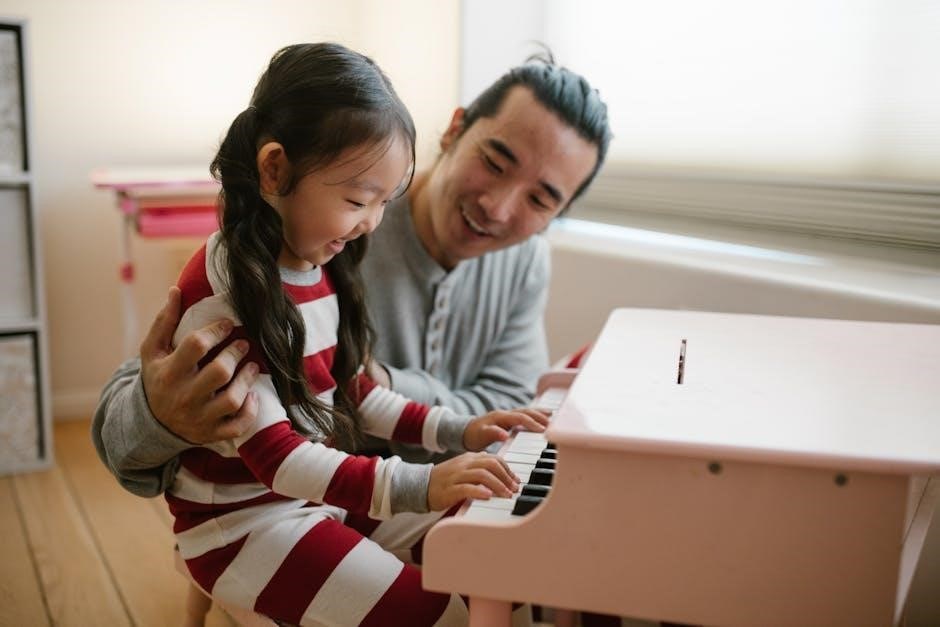
Modern Relevance of the Play
The Piano Lesson remains deeply relevant today, as its themes of family, identity, and heritage continue to resonate with modern audiences․ The struggle to balance cultural preservation with economic aspirations is a universal challenge, especially in communities navigating systemic inequality․ The play’s exploration of race and history aligns with contemporary conversations about social justice and the importance of understanding one’s roots․ Its focus on intergenerational conflict also speaks to modern debates about tradition versus progress․ Wilson’s work reminds us that the past is not just history but a living force that shapes our present and future, making The Piano Lesson a timeless and powerful exploration of the human experience․
The Piano Lesson by August Wilson masterfully explores universal themes of family, identity, and heritage, ensuring its enduring relevance and appeal across generations․
Final Thoughts on the Play’s Significance
The Piano Lesson stands as a profound exploration of cultural identity, family legacy, and racial heritage, weaving history through the symbolic piano․ August Wilson’s masterpiece captures the essence of African American experiences, resonating deeply with audiences․ Its themes of financial struggles and aspirations highlight universal human emotions, while the conflict over the piano embodies the tension between preserving the past and embracing the future․ The play’s ability to blend drama with musical and cultural elements ensures its enduring relevance․ As a cornerstone of African American theater, it continues to inspire new adaptations and discussions, cementing its place as a timeless classic in literary and theatrical history․
The Enduring Appeal of “The Piano Lesson”
The Piano Lesson remains a powerful and resonate work due to its universal themes of family, identity, and cultural heritage․ The play’s emotional depth and complex characters captivate audiences, fostering a deep connection to the story․ Its exploration of African American history and the struggle for preservation makes it a vital piece of cultural literature․ The blend of drama, music, and history creates a unique experience, ensuring its relevance across generations․ As a PDF, it continues to be a valuable resource for educational purposes, allowing readers to engage with August Wilson’s profound insights into race, legacy, and the human condition․
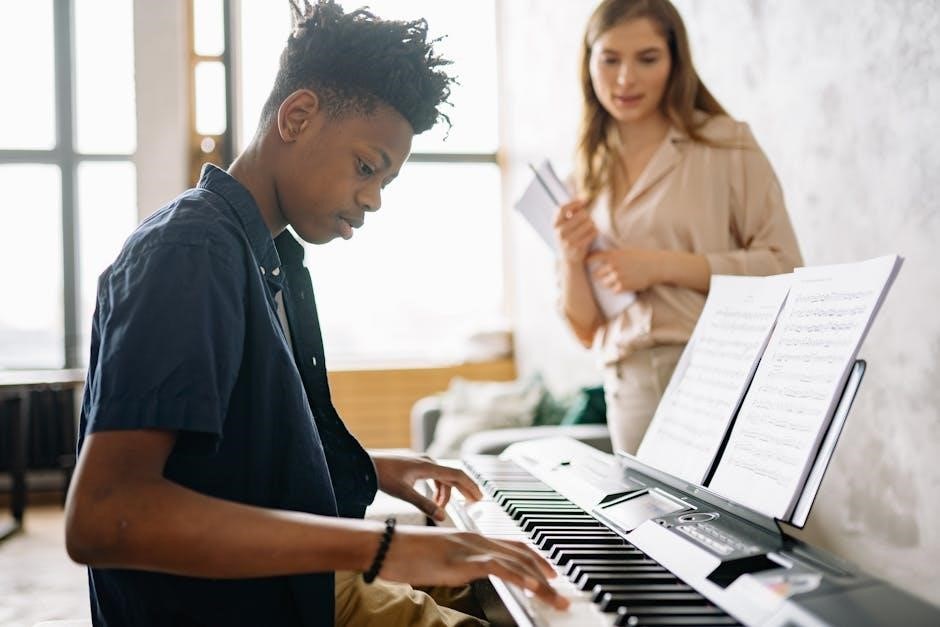
Where to Find “The Piano Lesson” in PDF Format
Access The Piano Lesson PDF through legitimate sources like university libraries, online marketplaces, or educational platforms․ Ensure compliance with copyright laws by using licensed copies․
Legitimate Sources for Educational Purposes
For educational purposes, The Piano Lesson PDF can be accessed through university libraries, online academic databases, or authorized eBook platforms․ Many institutions offer digital access to August Wilson’s plays․ Platforms like JSTOR, ProQuest, or Google Books may provide preview or full-text versions for research․ Additionally, eBook stores such as Amazon or Barnes & Noble often carry digital copies, which can be rented or purchased; Always ensure that the source is licensed and complies with copyright laws․ Universities and schools frequently include such works in their syllabi, making them accessible through their portals․ This ensures students and educators can engage with the material legally and ethically․
Importance of Accessing Licensed Copies
Accessing licensed copies of The Piano Lesson PDF is crucial to ensure compliance with copyright laws and support the creators of the work․ Licensed copies guarantee that the material is authentic and of high quality, free from unauthorized alterations․ Purchasing or accessing through legitimate platforms also contributes to the income of authors, publishers, and rights holders, promoting the sustainability of literary works․ Additionally, licensed copies often include supplementary materials, such as introductions or study guides, enhancing the educational experience․ By choosing licensed sources, users respect intellectual property rights and contribute to the preservation of literary heritage․ This practice also helps maintain the integrity of August Wilson’s work for future generations․


